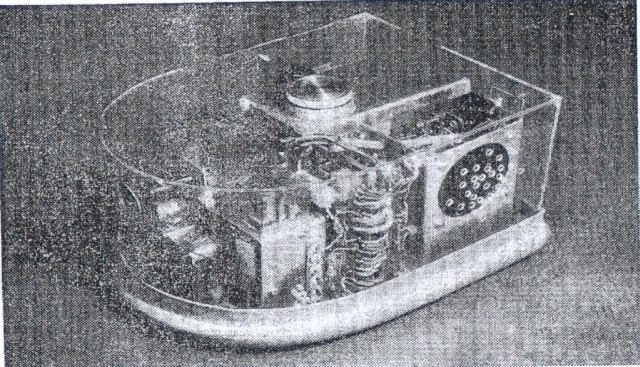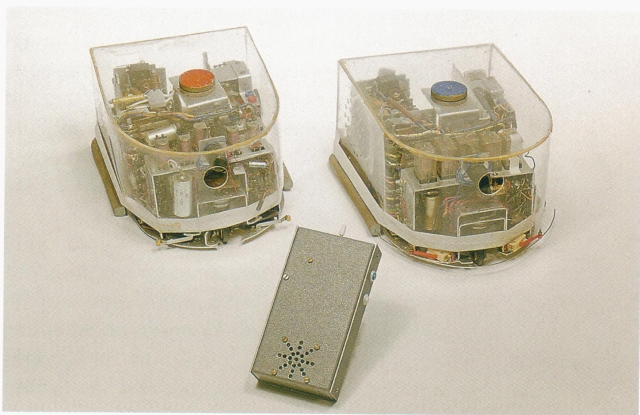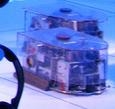
Either Hinz or Kunz as appeared in the 1962 Die Zeit article below.

Hinz and Kunz (I can’t tell who is who at this stage) together with the electronic whistle.

Hinz and Kunz appeared in the German robot exhibition “Die Roboter Kommen!” of 2007

Otto Walter Hasselof
RH Note: Hinz and Kunz are significant in that they are both M. Docilis type machines and interact and learn off each other. They are the only 2 known M. Docilis operating as a pair. Elmer and Elsie and batch of 6 were all M. Speculatrix. Cora was a M. Docilis.
German notes.
Elektromechanische „Schildkröten” als Verhaltensmodelle „Hinz & Kunz”, 1963 Deutsches Museum München
Die beiden Objekte, 1963 an der damaligen Pädagogischen Hochschule Berlin (West) von Haseloff, Gutschnied, Maas gebaut, stehen in der Tradition der ersten kybernetischen Versuchsanordnungen, mit denen das Verhalten künstlicher Organismen erforscht wurde. Die Bezeichnung „Schildkröten” für solche Maschinen, die sich mit einfachen Sensoren ausgestattet im Raum bewegten, geht auf den Wissenschaftler Grey Walter zurück. Er hatte 1949 an der University of the West of England in Bristol erstmals mit entsprechenden Experimenten begonnen und dafür die ersten „Turtles” gebaut.
English translation
Electromechanical “turtle” as a behavioural models “Hinz & Kunz”, 1963 Deutsches Museum in Munich
The two objects, 1963 at the former Pedagogical University Berlin (West) by Haseloff, Gutschnied, Maas built, stand in the tradition of the first cybernetic various configurations with which the behavior of artificial organisms explored. The name “turtle” for such machines, which are equipped with simple sensors in space moved it to the scientists Grey Walter. It had 1949 at the University of the West of England in Bristol first started experiments with and for the first ” Turtles’ built.
The following article from Die Zeit found here.
In German
Hinz und Kunz reagierten auf Pfiff
Arthur G. Bauer | © DIE ZEIT, 03.08.1962 Nr. 31
Lernprozesse werden an kybernetischen Modellen untersucht
Es war eine Premiere mit aller Spannung, die dazu gehört. Versammelt waren die Studenten der Pädagogischen Hochschule in Berlin. Ältere Semester, die dem Ereignis mit einigem Sachverstand entgegensahen, und die ganz Jungen, erst vor Tagen an der Pädagogischen Hochschule Berlin Immatrikulierten. Aufgeschlossen und erregt waren sie alle. Der Psychologe Prof. Dr. O. W. Haseloff hatte sie in den Vorraum der Turnhalle geladen, um ihnen „Hinz und Kunz” vorzustellen.
Für beide Akteure war in der Saalmitte ein Geviert von sechs Metern abgesperrt worden und dort lagen sie auf dem Boden. Hinz sah aus wie ein sehr großes, griffloses Bügeleisen, und Kunz glich Hinz aufs Schräubchen.
Einige Minuten rollten sie kreuz und quer auf ihren drei Rädern über den Boden, reagierten auf Signale und Hindernisse und zeigten überhaupt eine den Laien verblüffende Aktivität.
Hinz und Kunz sind „mechanische Schildkröten”, gebaut unter der Leitung Prof. Haseloffs von den ehemaligen Studenten der „PH” Gutschmidt und Maas. Es gibt von diesen Schildkröten bisher nur sehr wenige. Nichts wäre jedoch verfehlter, als die Geburt von Hinz und Kunz als bloße Kuriosität anzuzeigen. Sie haben nichts mit den Robotern und „künstlichen Tieren” gemein, die in großer Zahl in vergangenen Jahrhunderten gebaut wurden; besonders im 18. Jahrhundert, das in die Mechanikerkunst vernarrt war.
Hinz und Kunz sind kybernetische Verhaltensmodelle. Kybernetische Modelle, weil sie nach Prinzipien konstruiert sind, die für die Funktion automatischer Maschinen und des Nervensystems gleichermaßen gelten. Die Kybernetik ist eine Wissenschaft, die diese gemeinsamen Prinzipien aufzufinden sucht, und ihr Ziel ist eine Theorie, die das gesamte Gebiet der Kontrolle, Steuerung und Rückmeldung bei Maschinen und Lebewesen umfaßt.
Hinz und Kunz haben Rezeptoren — „Sinnesorgane” — die ihnen die Aufnahme von Informationen aus der Außenwelt ermöglichen. Sie „sehen” mit einer Photozelle, sie „hören” mit einem Mikrophon und sie „fühlen” mit einem Berührungskontakt. Ihre Effektoren, mit denen sie handeln können, sind ihr Motor und ihre drei Räder.Hinz und Kunz sind keine Automaten; das war schon bald zu sehen. Rezeptoren und Effektoren sind bei Automaten starr miteinander verbunden: Automaten haben ein starres Programm. Ein Zigarettenautomat wirft für eine Mark eine Schachtel Zigaretten aus; nur zu dieser und zu keiner anderen Aktivität ist er mit der Münze zu reizen. Er antwortet mit einem unbedingten Reflex.
Bei mechanischen Schildkröten sind die Verbindungen zwischen den Rezeptoren und Effektoren mehr oder weniger flexibel, und Hinz und Kunz zeigten das besonders deutlich.
Wir sahen Hinz auf eine Glühbirne zustreben und sich dann, wenige Zentimeter davor, „geblendet” von ihr abwenden. Kunz rollte gegen ein Hindernis und kehrte um. Dann reagierte Kunz auch auf einen Pfiff: er „stellte sich tot”, er blieb stehen. Nun aber begann einer seiner Erbauer jedesmal zu pfeifen, wenn Kunz gegen ein Hindernis rollte. Bald konnte er pfeifen wann er wollte, Kunz stellte sich dann nicht mehr tot sondern wandte sich wie vor einem Hindernis ab. Kunz zeigte einen bedingten Reflex; er hatte gelernt. Um auch Hinz gerecht zu werden: er kam gleich danach an die Reihe und zeigte sich nicht dümmer als Kunz.
Die Möglichkeit, mit diesen Modellen Lernprozesse zu simulieren, erklärt das große Interesse der Psychologie an den mechanischen Schildkröten und der Kybernetik überhaupt. Solche Modelle sind möglich durch die Gleichartigkeit der Funktionen der Dioden ihres Speichers mit den Neuronen des Nervensystems. Nützlich sind sie, weil eine experimentelle Arbeit an Problemen unmöglich ist, wenn die aktiven Elemente weder gesteuert noch eliminiert werden können.
Hinz und Kunz zeigten schon bei ihrer ersten Vorführung die nach heutiger Auffassung “wichtigsten Prinzipien des Lernens: Konditionierung und Verhaltensorganisation nach statistischen Gesetzen. Die hinreichend gleichzeitige und häufige Koppelung von Pfiff und Kontaktberührung konditionierte Hinz und Kunz an den Pfiff. Auch bei Lebewesen tritt der bedingte Reflex nur auf, wenn beide Reize häufiger zusammenfallen als es zufällig der Fall sein könnte. Nur dann ist der Reiz „lernenswert”.
Hinz und Kunz sind hauptsächlich aus vorgefertigten Teilen gebaut worden. So erreichten ihre Materialkosten noch nicht einmal 3000 Mark. Die Grundlagen der Konstruktion mußten sich die Erbauer neben dem Studium aneignen. Ihre Arbeit ist ein Geschenk an die Hochschule.
Nahmen Hinz und Kunz Kenntnis voneinander? Hinz reagierte jedenfalls auf den Output des Kunz und dieser auch auf die Pfiffe seines Bruders. Jeder pfiff, wenn er sich drehte, auf eigener Frequenz und brachte dadurch seinen Partner dazu, sich ebenfalls umzudrehen. Das war enttäuschend wenig für diejenigen, die menschliche Züge vom. Verhaltensmodell erwartet hatten. Für den Psychologen aber ist es eine wertvolle Möglichkeit, Kommunikation, wenn auch einfachster Art, an Modellen studieren zu können, deren weiterer Ausbau prinzipiell durchaus möglich ist. -Arthur G. Bauer.
English translation (rough)
Hinz and Kunz reacted to a whistle
Arthur G. Bauer | © DIE ZEIT, 03.08.1962 Nr. 31
Learning processes are examined as cybernetic models.
It was a premiere with all the tension, which belongs to it. The students of the College of Education in Berlin were gathered. Older semester, the event with some expert knowledge, and the very young, only days before being registered at the Pedagogical University Berlin. They were unleashed all excited. The psychologist Prof. Dr. Otto Walter Haseloff was in the anteroom of the gymnasium loaded to them “Hinz and Kunz”.
Both participants were placed on the ground in the middle hall closed off by a six meters square pen. Hinz looked like a very large, plastic steam-iron, and Kunz resembled Hinz as a collection of spare parts.
A few minutes they rolled the length and breadth with their three wheels on the ground, responded to signals and obstacles at all and showed all the laymen amazing activity.
Hinz and Kunz are “mechanical turtles”, built under the direction of Prof. Haseloff’s former students of the “PH” Gutschmidt and Maas. So far there are only a very few of these turtles. Nothing would be failures, as the birth of Hinz and Kunz as a mere curiosity. You have nothing in common with the robots and “artificial animals” , built in large numbers in past centuries, especially in the 18th century, into the mechanic was infatuated with art.
Hinz and Kunz are cybernetic behavioral models. Cybernetic models, because they are designed for the principles of machines and automatic function of the nervous system alike. The Cybernetics is the science that seeks common principles detect, and their goal is a theory that the whole area of monitoring, control and feedback for machinery and includes living organisms.
Hinz and Kunz have receptors – “sensory organs” – to them by the inclusion of information from the outside world. “See” with a photo cell, they “hear” with a microphone and they “feel” with a touch contact. Your effectors with which they can act, it must Motor and its three wheels.Hinz and Kunz are not machines, which was soon to be seen. Receptors and effectors are rigidly connected machines: machines have a rigid program. A cigarette machine throws for a market cigarettes from a box and only on this and any other activity he is with the coin to irritate. He responds with an unconditional reflex.
For mechanical turtles are the connections between the receptors and effectors more or less flexible, and Hinz and Kunz showed the particularly clear.
We saw a light bulb to Hinz zustreben and then, a few centimeters of being “blinded” by her away. Kunz rolled against an obstacle and returned. Then Kunz also responded to a whistle: he “was dead,” he stopped. But now one of its builders began to whistle every time when Kunz rolled against an obstacle. Soon, he could whistle when he wanted, Kunz was then no longer dead but turned to remain an obstacle. Kunz showed a conditional reflex, he had learned. To Hinz needs: he came immediately afterwards in the series and was not as stupid Kunz.
The possibility of learning with these models to simulate explains the great interest in psychology at the mechanical turtles and cybernetics at all. Such models are possible because of the similarity of the functions of the diodes their memory with the neurons of the nervous system. They are useful because an experimental work on problems is impossible, if the active elements neither controlled nor can be eliminated.
Hinz and Kunz showed during their first demonstration today to consider the “main principles of learning: conditioning and organization to conduct statistical laws. The simultaneous and sufficiently frequent link between whistle and contact touch conditioned Hinz Kunz and to the whistle. Even when living creatures joins the conditional Reflex only when both stimuli coincide more often than is the case at random. Only then is the attraction “lernenswert”.
Hinz and Kunz are mainly built from prefabricated parts. To meet their material costs have not even Mark 3000. The foundations of the construction had to the builders next to the appropriate studies. Their work is a gift to the university.
Hinz Kunz names and knowledge of each other? Hinz responded to any of the output Kunz and this also to the whistling of his brother. Everyone whistled when he turned on his own frequency and thus brought its partners to do likewise turn. That was disappointing enough for those human traits of. Model behavior expected. For psychologists, however, it is a valuable opportunity, communications, although the simplest way to study models, their further expansion is possible in principle. -Arthur G. Bauer.